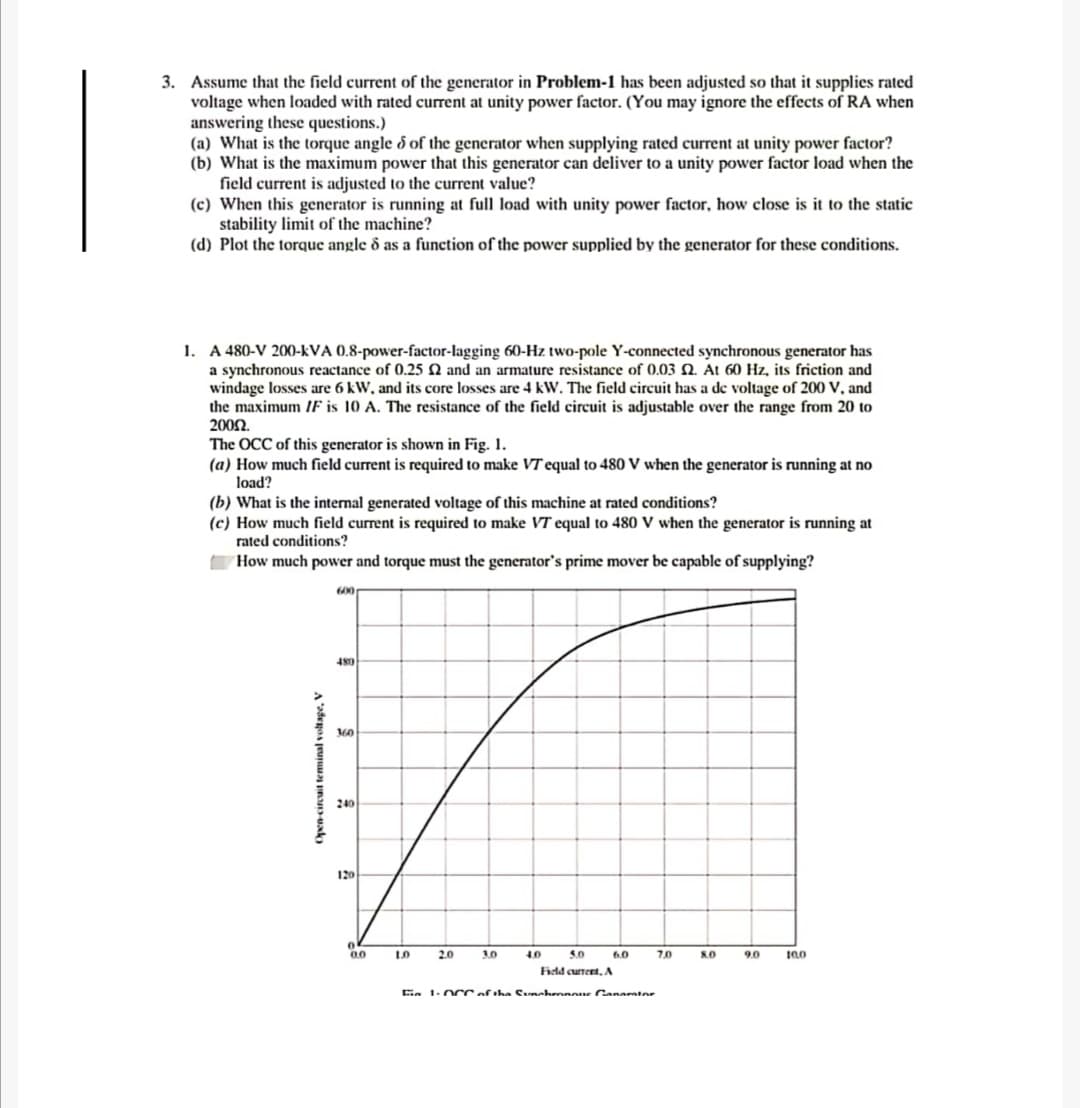3. Assume that the field current of the generator in Problem-1 has been adjusted so that it supplies rated voltage when loaded with rated current at unity power factor. (You may ignore the effects of RA when answering these questions.) (a) What is the torque angle o of the generator when supplying rated current at unity power factor? (b) What is the maximum power that this generator can deliver to a unity power factor load when the field current is adjusted to the current value? (c) When this generator is running at full load with unity power factor, how close is it to the static stability limit of the machine? (d) Plot the torque angle ô as a function of the power supplied by the generator for these conditions.
3. Assume that the field current of the generator in Problem-1 has been adjusted so that it supplies rated voltage when loaded with rated current at unity power factor. (You may ignore the effects of RA when answering these questions.) (a) What is the torque angle o of the generator when supplying rated current at unity power factor? (b) What is the maximum power that this generator can deliver to a unity power factor load when the field current is adjusted to the current value? (c) When this generator is running at full load with unity power factor, how close is it to the static stability limit of the machine? (d) Plot the torque angle ô as a function of the power supplied by the generator for these conditions.
Introductory Circuit Analysis (13th Edition)
13th Edition
ISBN:9780133923605
Author:Robert L. Boylestad
Publisher:Robert L. Boylestad
Chapter1: Introduction
Section: Chapter Questions
Problem 1P: Visit your local library (at school or home) and describe the extent to which it provides literature...
Related questions
Question
Solve question no 3
(Don't provide incomplete solution)

Transcribed Image Text:3. Assume that the field current of the generator in Problem-1 has been adjusted so that it supplies rated
voltage when loaded with rated current at unity power factor. (You may ignore the effects of RA when
answering these questions.)
(a) What is the torque angle d of the generator when supplying rated current at unity power factor?
(b) What is the maximum power that this generator can deliver to a unity power factor load when the
field current is adjusted to the current value?
(c) When this generator is running at full load with unity power factor, how close is it to the static
stability limit of the machine?
(d) Plot the torque angle ô as a function of the power supplied by the generator for these conditions.
1. A 480-V 200-kVA 0.8-power-factor-lagging 60-Hz two-pole Y-connected synchronous generator has
a synchronous reactance of 0.25 N and an armature resistance of 0.03 N. At 60 Hz, its friction and
windage losses are 6 kW, and its core losses are 4 kW. The field circuit has a de voltage of 200 V, and
the maximum IF is 10 A. The resistance of the field circuit is adjustable over the range from 20 to
2002.
The OCC of this generator is shown in Fig. 1.
(a) How much field current is required to make VT equal to 480 V when the generator is running at no
load?
(b) What is the internal generated voltage of this machine at rated conditions?
(c) How much field current is required to make VT equal to 480 V when the generator is running at
rated conditions?
How much power and torque must the generator's prime mover be capable of supplying?
600
480
360
240
120
0.0
LO
2.0
30
4.0
5.0
6.0
7.0
S.O
9.0
Fidd current, A
in 1.OcCof the Cunahennnne anarator
Open circait teminal voltape, V
Expert Solution
This question has been solved!
Explore an expertly crafted, step-by-step solution for a thorough understanding of key concepts.
This is a popular solution!
Trending now
This is a popular solution!
Step by step
Solved in 4 steps

Knowledge Booster
Learn more about
Need a deep-dive on the concept behind this application? Look no further. Learn more about this topic, electrical-engineering and related others by exploring similar questions and additional content below.Recommended textbooks for you

Introductory Circuit Analysis (13th Edition)
Electrical Engineering
ISBN:
9780133923605
Author:
Robert L. Boylestad
Publisher:
PEARSON

Delmar's Standard Textbook Of Electricity
Electrical Engineering
ISBN:
9781337900348
Author:
Stephen L. Herman
Publisher:
Cengage Learning

Programmable Logic Controllers
Electrical Engineering
ISBN:
9780073373843
Author:
Frank D. Petruzella
Publisher:
McGraw-Hill Education

Introductory Circuit Analysis (13th Edition)
Electrical Engineering
ISBN:
9780133923605
Author:
Robert L. Boylestad
Publisher:
PEARSON

Delmar's Standard Textbook Of Electricity
Electrical Engineering
ISBN:
9781337900348
Author:
Stephen L. Herman
Publisher:
Cengage Learning

Programmable Logic Controllers
Electrical Engineering
ISBN:
9780073373843
Author:
Frank D. Petruzella
Publisher:
McGraw-Hill Education

Fundamentals of Electric Circuits
Electrical Engineering
ISBN:
9780078028229
Author:
Charles K Alexander, Matthew Sadiku
Publisher:
McGraw-Hill Education

Electric Circuits. (11th Edition)
Electrical Engineering
ISBN:
9780134746968
Author:
James W. Nilsson, Susan Riedel
Publisher:
PEARSON

Engineering Electromagnetics
Electrical Engineering
ISBN:
9780078028151
Author:
Hayt, William H. (william Hart), Jr, BUCK, John A.
Publisher:
Mcgraw-hill Education,